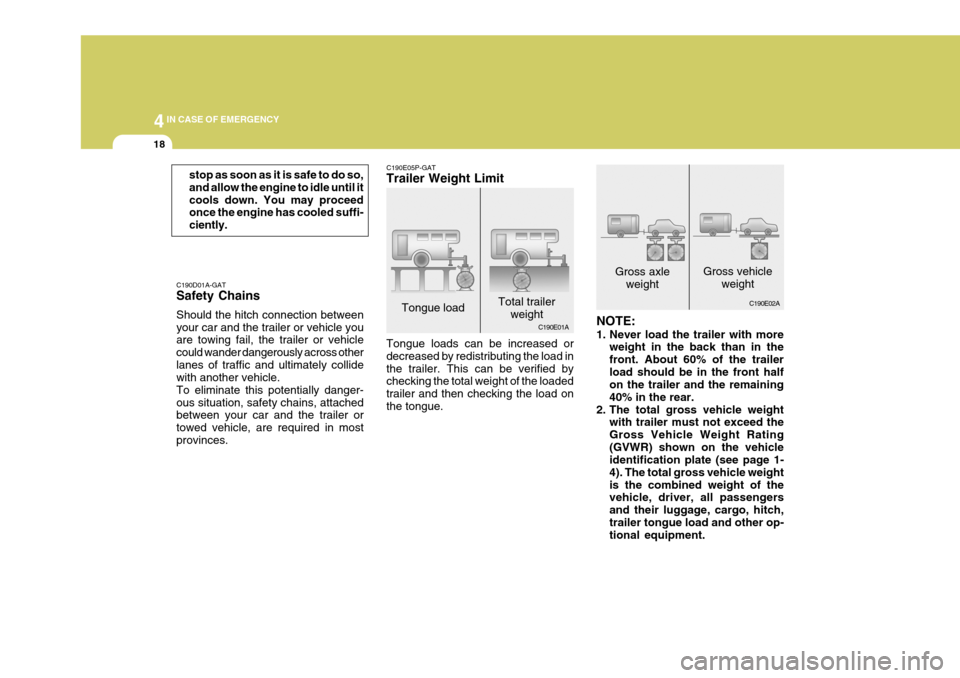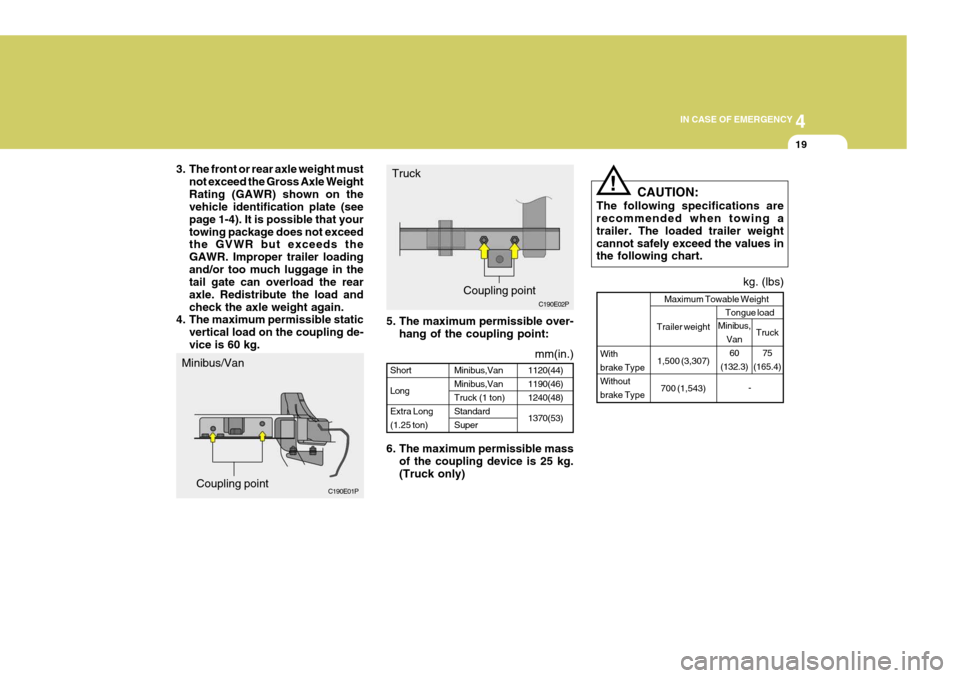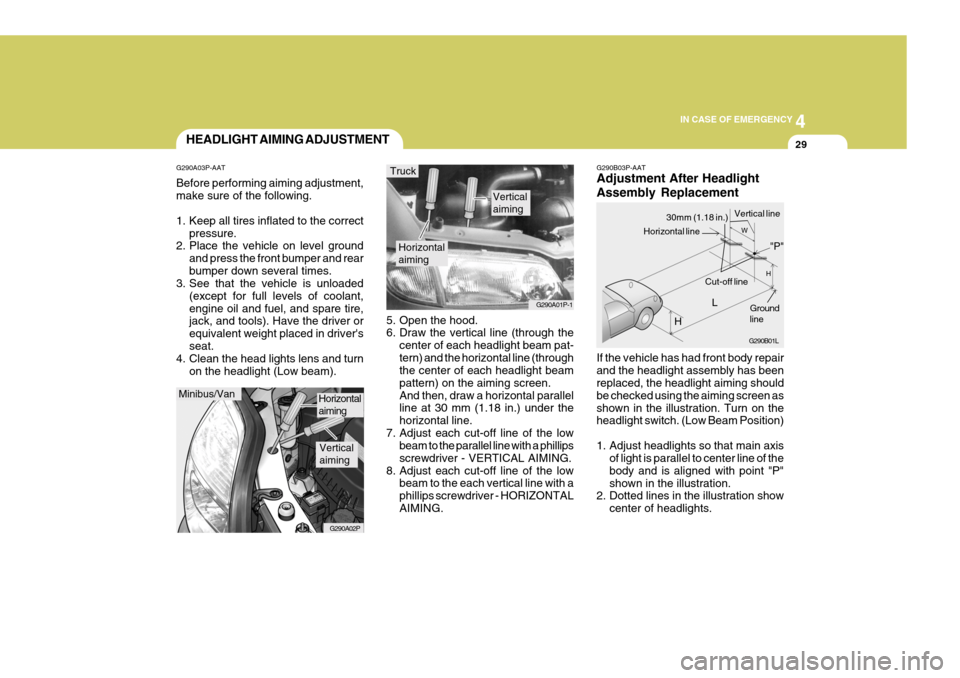Page 194 of 284

44IN CASE OF EMERGENCY
18
stop as soon as it is safe to do so, and allow the engine to idle until itcools down. You may proceed once the engine has cooled suffi- ciently.
C190D01A-GAT Safety Chains Should the hitch connection between your car and the trailer or vehicle you are towing fail, the trailer or vehicle could wander dangerously across otherlanes of traffic and ultimately collide with another vehicle. To eliminate this potentially danger-ous situation, safety chains, attached between your car and the trailer or towed vehicle, are required in mostprovinces. C190E05P-GAT Trailer Weight Limit Tongue loads can be increased or decreased by redistributing the load inthe trailer. This can be verified by checking the total weight of the loaded trailer and then checking the load onthe tongue.
NOTE:
1. Never load the trailer with more
weight in the back than in the front. About 60% of the trailerload should be in the front half on the trailer and the remaining 40% in the rear.
2. The total gross vehicle weight with trailer must not exceed theGross Vehicle Weight Rating(GVWR) shown on the vehicle identification plate (see page 1- 4). The total gross vehicle weightis the combined weight of the vehicle, driver, all passengers and their luggage, cargo, hitch,trailer tongue load and other op- tional equipment.
Tongue load
Total trailer
weight Gross axle
weight Gross vehicle
weight
C190E01A C190E02A
Page 195 of 284

4
CORROSION PREVENTION AND APPEARANCE CARE
19
4
IN CASE OF EMERGENCY
19
5. The maximum permissible over-
hang of the coupling point:
6. The maximum permissible mass of the coupling device is 25 kg. (Truck only) CAUTION:
The following specifications are recommended when towing a trailer. The loaded trailer weightcannot safely exceed the values in the following chart.
!
Truck
Coupling point
1120(44) 1190(46)1240(48) 1370(53)
ShortLongExtra Long (1.25 ton) Minibus,VanMinibus,VanTruck (1 ton)StandardSuper
kg. (lbs)
With brake TypeWithoutbrake Type Maximum Towable Weight
Trailer weight
1,500 (3,307) 700 (1,543) Tongue load
-
Minibus,
Van60
(132.3) Truck
75
(165.4)
C190E02P
mm(in.)
C190E01P
3. The front or rear axle weight must
not exceed the Gross Axle Weight Rating (GAWR) shown on the vehicle identification plate (see page 1-4). It is possible that yourtowing package does not exceed the GVWR but exceeds the GAWR. Improper trailer loadingand/or too much luggage in the tail gate can overload the rear axle. Redistribute the load andcheck the axle weight again.
4. The maximum permissible static
vertical load on the coupling de-vice is 60 kg.
Minibus/Van
Coupling point
Page 205 of 284

4
CORROSION PREVENTION AND APPEARANCE CARE
29
4
IN CASE OF EMERGENCY
29
G290B03P-AAT Adjustment After Headlight Assembly Replacement If the vehicle has had front body repair and the headlight assembly has been replaced, the headlight aiming should be checked using the aiming screen asshown in the illustration. Turn on the headlight switch. (Low Beam Position)
1. Adjust headlights so that main axis
of light is parallel to center line of the body and is aligned with point "P"shown in the illustration.
2. Dotted lines in the illustration show
center of headlights.
5. Open the hood.
6. Draw the vertical line (through the
center of each headlight beam pat- tern) and the horizontal line (through the center of each headlight beam pattern) on the aiming screen.And then, draw a horizontal parallel line at 30 mm (1.18 in.) under the horizontal line.
7. Adjust each cut-off line of the low beam to the parallel line with a phillipsscrewdriver - VERTICAL AIMING.
8. Adjust each cut-off line of the low beam to the each vertical line with aphillips screwdriver - HORIZONTALAIMING.
Horizontal aiming
Verticalaiming
G290A01P-1
Truck
G290B01L
LW
H
H Cut-off line
Ground line
"P"
Horizontal line
30mm (1.18 in.) Vertical line
HEADLIGHT AIMING ADJUSTMENT
G290A03P-AAT Before performing aiming adjustment, make sure of the following.
1. Keep all tires inflated to the correct pressure.
2. Place the vehicle on level ground
and press the front bumper and rear bumper down several times.
3. See that the vehicle is unloaded
(except for full levels of coolant,engine oil and fuel, and spare tire, jack, and tools). Have the driver or equivalent weight placed in driver'sseat.
4. Clean the head lights lens and turn
on the headlight (Low beam).
Minibus/Van
G290A02P
Horizontal aiming
Verticalaiming
Page 226 of 284

5
APPEARANCE CARE
5
F010O01P-GAT
Load weight and driving speed
Remove any luggage, etc., which is
not necessary from the vehicle. The load weight placed on the roof or towed in a trailer also should not be exces-sive. Correctly adjusting the air pressure of
the tires before driving under maxi- mum load weight conditions and be- fore driving long distances is espe-cially important. F010P01P-GAT
Tire replacement
Tires which do not meet the size
specifications must not be used. Re- placement of the tires must be made as a set of the two front tires, the tworear tires, or all four tires. A mixture of bias-ply tires and radial
tires must not be used. Consult an authorized HYUNDAI dealer regarding tire replacement.
F010Q01P-GAT
Kerb parking
If the tires strike a kerb or concrete
parking barrier, they could be dam-aged, and this damage could become a source of extreme danger when the vehicle is subsequently driven at highspeed. If the vehicle is to be driven or onto a kerb or any other such barrier, it should be driven slowly and at anappropriate angle to the kerb or barrier. F010R01P-GAT
Tire care
For driving safely, and in order toobtain the maximum useful life of thetires, the following points should be observed. For information concerning inspection, air pressure, and rotationof the tires, refer to the part which deals with wheels in the section of this manual entitled "Consumer Informa-tion". F010S01P-GAT Tire air pressure The air pressure of the tires must always be maintained in accordance with the specifications, and should be measured when the tires are cool.If any changes in driving conditions(speed and/or load weight) occur, theair pressure of the tires must meet the specifications which apply to the new driving conditions. If the vehicle isgoing to be driven under varying load weight, etc., the air pressure must be adjusted in order to meet the highestspecifications of the conditions under which the vehicle is driven (high speeds and maximum load weight). F010T01P-GAT Tire storage Storage of the tires should be in a dark, well-ventilated place.Tires not mounted on rims should bestored vertically. Be sure that the tires are not in contact with fuel, oil grease, etc.